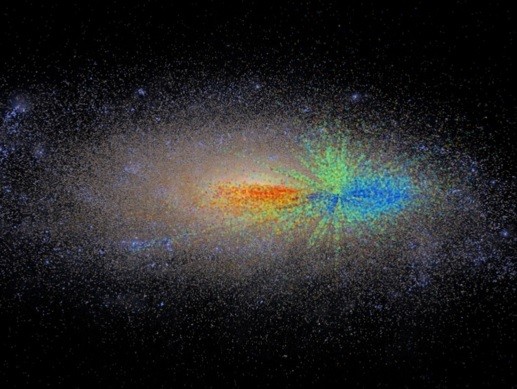By Ana Verayo, | January 10, 2016

Age distribution for a sample of red giant stars ranging from the galactic center to the outskirts of the Milky Way. Age is color coded, with the youngest stars shown in blue, the oldest stars in red, and middle-aged stars in green.
Astronomers have created a new growth chart or age map of the Milky Way galaxy where new data reveals how the galaxy developed and evolved from a newly born one to an incredible spiral shaped galaxy, spanning 100,000 to 160,000 light years across the universe.
Like Us on Facebook
This age map reveals how the Milky Way expanded outward along with older stars that have been gravitating close by the galactic core. The younger stars can also be located on the edges of the Milky Way.
In this new study, astronomers have determined how red giants or stars that are in their final stages of their lifetimes were apparently pivotal in building this Milky Way age map. Astronomers from the Max Planck Institute for Astronomy measured 70,000 red giants using valuable data obtained by the APOGEE (Apache Point Observatory Galaxy Evolution Experiment) survey.
In the course of seven years, APOGEE researchers have discovered enough red giants in order to create this map however, they needed more data from the planet hunting Kepler Space Telescope to accurately identify the age of about 7,000 stars where the team then applied this data to this new model to also determine the ages of 70,000 red giants.
According to Melissa Ness of the Max Planck Institute for Astronomy in Germany, closer to the center of the galaxy are older stars that were formed when the Milky Way was young and small. On the fringes are younger stars which means that our galaxy grew up by growing out.
Past research also theorized how the Milky Way was able to grow out from inside outwards. Since our galaxy was formed some 13.6 billion years ago, dark matter which is believed to comprise the invisible matter that makes up the universe, surrounded the Milky Way.
As the gravitational forces of the dark matter attracted elements like hydrogen and helium together, these gases eventually cooled down, producing the first generation of stars. Dwarf galaxies and subhalos which are clusters of stars, were now drawn inwards since dark matter lies within the core of the young Milky Way.
When these gases and dwarf galaxies engage in a massive collision, they travel slower and deeper into the center of the Milky Way, where this core gains more mass, spinning at a faster rate as the center formed a disk shape. The rest of the spiral arms of the Milky Way were formed from stellar activity from gases and other dwarf galaxies.
This new age map of the Milky Way now confirms this theory, where future research can now be based on data from the APOGEE survey along with other galactic surveys in order to determine how stars formed inside the Milky Way and their timelines. Furthermore, astronomers can also gain a better understanding of how elements were combined to form stars and how these elements triggered life on Earth.
-
Use of Coronavirus Pandemic Drones Raises Privacy Concerns: Drones Spread Fear, Local Officials Say

-
Coronavirus Hampers The Delivery Of Lockheed Martin F-35 Stealth Fighters For 2020

-
Instagram Speeds Up Plans to Add Account Memorialization Feature Due to COVID-19 Deaths

-
NASA: Perseverance Plans to Bring 'Mars Rock' to Earth in 2031

-
600 Dead And 3,000 In The Hospital as Iranians Believed Drinking High-Concentrations of Alcohol Can Cure The Coronavirus

-
600 Dead And 3,000 In The Hospital as Iranians Believed Drinking High-Concentrations of Alcohol Can Cure The Coronavirus

-
COVID-19: Doctors, Nurses Use Virtual Reality to Learn New Skills in Treating Coronavirus Patients







